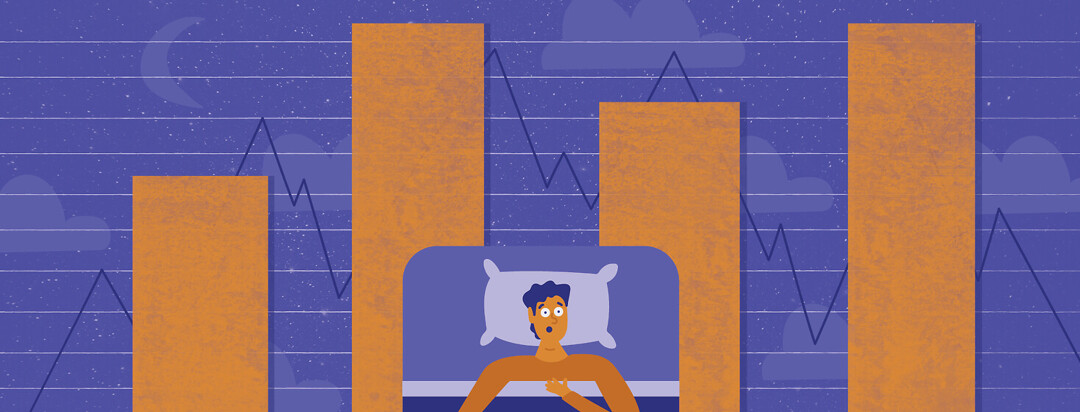Do Arousals Matter in Sleep Apnea? Yes!
If you awaken frequently or feel unrested after a night of sleep, you may be experiencing something known as sleep instability. Sleep instability is often caused by frequent arousals during sleep.
Arousals are defined as sudden shifts that abruptly pull you from deeper stages of sleep into lighter ones. Sometimes they lead to complete awakenings. However, even arousals you don’t notice can lead to chronic sleep instability.
People with obstructive sleep apnea (OSA) encounter sleep instability all night long. This explains why they’re tired all the time and why untreated OSA can lead to worsening health.
Connecting the dots: sleep instability
We all experience arousals during sleep. Arousals are, in fact, normal. We don’t spend all of our time in 1 stage of sleep, but in several:1
- Stage 1 sleep (5 percent of the night) – very shallow sleep frequently experienced between other stages of sleep as a transition
- Stage 2 sleep (half of the night) – where we spend most of our sleep
- Stage 3 sleep (20 percent of the night) – deep, dreamless sleep
- Stage R, or rapid-eye movement (REM) sleep (a quarter of the night) – an “active” form of sleep spent dreaming
Each time we shift from deeper stages of sleep, we experience an arousal. The ultimate arousal happens the moment we open our eyes in the morning to wake up.
When we have more arousals than normal, this describes a low arousal threshold, which can lead to fragmented sleep.
The problem of fragmented sleep
Without regular, adequate amounts of Stage 2 and REM sleep, we’re more likely to struggle with mental health during the day.2
Sleep fragmentation, by whatever cause, is also considered a potential “gateway” to major chronic illness such as heart disease, diabetes, stroke, and more.3
Sleep apnea and arousals
OSA is a chief cause for excessive arousals during sleep. It makes sense. We can’t breathe, so we wake up so we can breathe again. Problem solved, right? Nope. Repeated episodes of sleep fragmentation every single night actually worsen the dilemma.
Here’s why: Simply put, the levels of oxygen and carbon dioxide in the blood are out of balance. During an apnea, a blocked upper airway makes both inhaling and exhaling impossible. Two things result:
- There’s not enough oxygen for our cells to continue functioning without distress. This alerts the brain to take steps to correct the shortage.
- Meanwhile, obstructions to our upper airway mean we’re also unable to exhale the excess carbon dioxide. Too much of this toxic waste product also sets off alarms.
How the brain responds to imbalanced levels
The brain responds to this critical imbalance by flooding the body with stress hormones. Stress hormones “talk” to other systems in the body to set up a fight or flight response. If you’ve ever witnessed someone having an apnea, who snorts or kicks themselves awake, you’ve seen this process in action.
Once awakened, we can voluntarily breathe again. Taking those breaths corrects the imbalance of oxygen and carbon dioxide levels in the bloodstream. But it also means we also find ourselves wide awake, our hearts pounding, our blood pressure elevated, our minds racing.
This reveals the dangerous nature of sleep fragmentation and the reason we should try to avoid it at all costs.
The sleep study: understanding your arousal index
A sleep study is the only way to determine your arousal threshold, as yours may differ from the next person’s.
Tests for OSA automatically measure arousals, leading to a final number known as your arousal index. The higher your arousal index number, the more problems you’re going to have with daytime sleepiness and other impacts from untreated OSA.
According to the American Sleep Apnea Association, as few as 5 arousals per hour can lead to daytime sleepiness; in the most severe cases of OSA, the index can measure more than 100 per hour.4
Doctors use your arousal index number to gauge the severity of your OSA so they can help you choose the best therapy moving forward.
How are arousals measured in the lab?
During a sleep study, several sensors are applied to your body. The following capture evidence of arousals:
- The elastic belts which capture the “respiratory effort” your body makes as it tries to breathe during an apnea
- Snap electrodes placed on the legs which measure sudden movements associated with apneas
- Scalp electrodes which trace brainwave patterns to identify different stages of sleep capturing transitions and arousals
Many people resist getting a sleep study because they don’t understand why they have to sleep with so many wires affixed to the body.
Each and every sensor has a specific job in capturing health data that, when combined at the end of a night of sleep, can tell a comprehensive story about the presence and nature of your own sleep instability.

Join the conversation